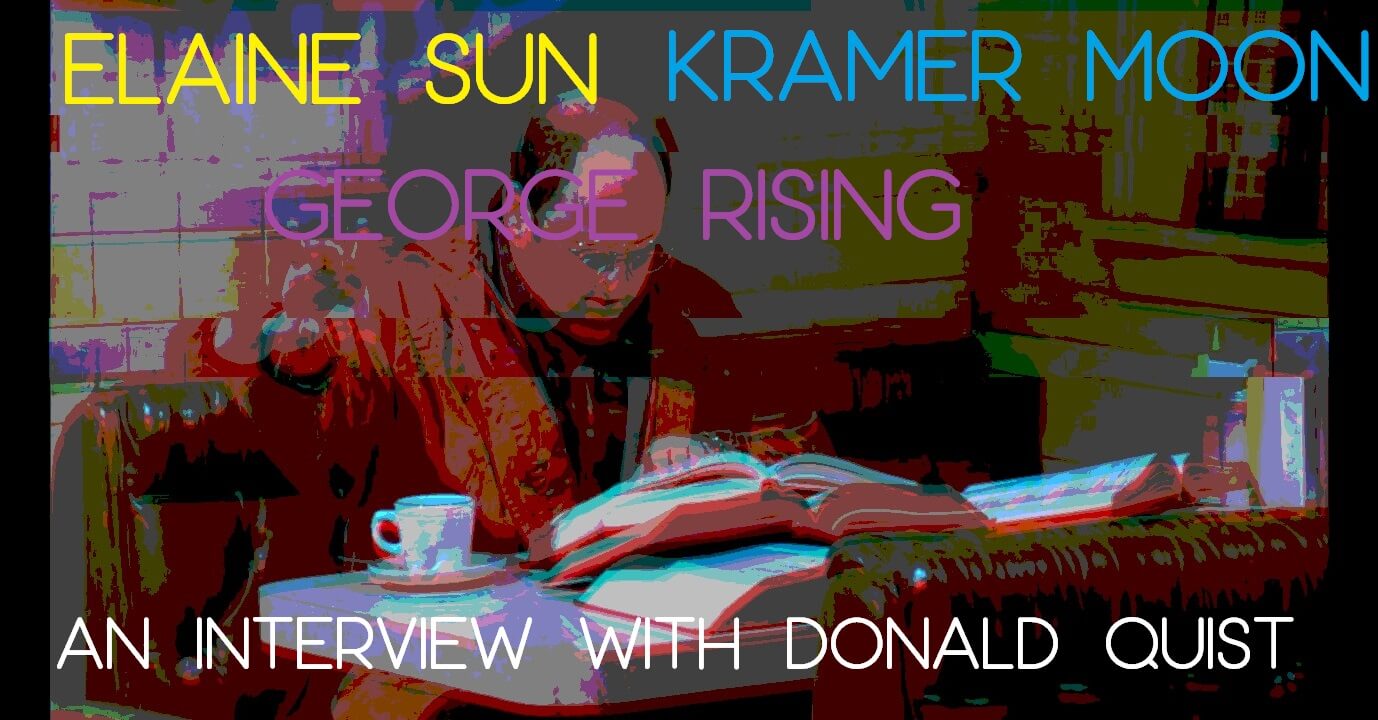 In his new podcast, Seinfeld Book Report (in which he discusses the texts Seinfeld characters are reading and how they connect to other aspects of 1990s culture), Donald Quist begins each episode with corrections to the last. That’s what he calls them, anyway—but they’re more often like addenda or footnotes: further thoughts on previous thinking. For example, in a recent episode, he elaborates on a comment he made about how one of the show’s ex-girlfriend characters, Marlene, had seemed like “a surrogate for what writers perceive Southerners to be” because of her accent. “I want to go a little more into that,” he says, and then describes how writers and media have used Southern accents as facile shorthand for a lack of intelligence, thus perpetuating unjust stereotypes about an entire region. So, the “corrections” segment functions as much as a corrective to larger societal failures as it does to simple factual errors.
In his new podcast, Seinfeld Book Report (in which he discusses the texts Seinfeld characters are reading and how they connect to other aspects of 1990s culture), Donald Quist begins each episode with corrections to the last. That’s what he calls them, anyway—but they’re more often like addenda or footnotes: further thoughts on previous thinking. For example, in a recent episode, he elaborates on a comment he made about how one of the show’s ex-girlfriend characters, Marlene, had seemed like “a surrogate for what writers perceive Southerners to be” because of her accent. “I want to go a little more into that,” he says, and then describes how writers and media have used Southern accents as facile shorthand for a lack of intelligence, thus perpetuating unjust stereotypes about an entire region. So, the “corrections” segment functions as much as a corrective to larger societal failures as it does to simple factual errors.
I can’t think of another podcast that does this as a principled matter of course instead of as an occasional gesture. Folding each episode into the next one, like an expert pâtissier laminating dough, makes the installments feel less like isolated episodes and more like an ongoing conversation—with the audience; with himself; with Jerry, George, Kramer, and Elaine; and with American culture at large.
If that sounds like a lot for one podcast to take on, don’t worry. You’re in good hands. Donald Quist has been having these conversations for a long time as a writer and educator, and he is unfailingly thoughtful, probing, and attentive to complexity in every context. Before we embarked on the following interview, he said he wanted it to be more of a conversation than a Q&A, so we spent a couple weeks emailing back and forth about Seinfeld astrology, making and engaging with art, MacGuffins, poetry, the pleasures of list-making, and more. Giddyup!
Caylin Capra-Thomas: In Seinfeld Book Report, you consistently emphasize your broad understanding of the term “text,” putting forth such material as Harlequin romance novels, auto magazines, comic books, and self-help books as literature worthy of close reading. This made me remember a moment when, asked what kind of writer you are, you called yourself a poet in the ancient Greek sense of the word—a maker. How did you come to this understanding, and how does this holistic approach to notions of both writer and writing inform the way you make art?
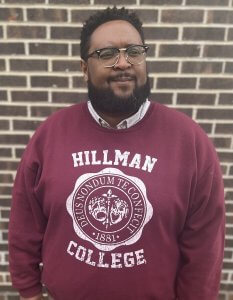 Donald Quist: I’ve always been wary of specialization, I guess. I think one of the biggest mistakes an artist can make is to define themselves by what they make, by one of their specialties. I’ve told this to people before, but I’ve wanted to be a writer since I was five. I didn’t claim a particular genre as an identity. I’ve worried that if I began to define myself as only a creative nonfiction writer, or essayist, I could close myself off to opportunities to make something awesome in another genre and/or medium.
Donald Quist: I’ve always been wary of specialization, I guess. I think one of the biggest mistakes an artist can make is to define themselves by what they make, by one of their specialties. I’ve told this to people before, but I’ve wanted to be a writer since I was five. I didn’t claim a particular genre as an identity. I’ve worried that if I began to define myself as only a creative nonfiction writer, or essayist, I could close myself off to opportunities to make something awesome in another genre and/or medium.
This is hard in academia, which so often rewards specialization. Master-level programs promote distinctions between genres because it makes the creative process easier to teach, standardize, and grade. Higher education is thankfully becoming more interdisciplinary. (Some could argue that is a result of economic concerns that prompt departments to seek out educators who can teach more things and trim department budgets. But anyway…) Moving away from specialization and embracing interdisciplinary and multi-genre approaches to both art and scholarship feels more intuitive to me.
Holistic…I love that word and how it implies inclusivity. Part of creative and scholarly inclusivity involves broadening ideas about texts to better accommodate the different ways we learn and to navigate our human experiences.
Does any of that resonate with you? You write poetry. Your collection Iguana Iguana is so damn good. But I think of you primarily as a multi-genre artist working on and off the page—you’re really good at making up and performing tunes too.
CCT: I really love your self-designation as “maker,” and when I’m feeling generous with myself, that resonates with me, too. Not everything I make is something I’d want to impose on anyone outside my friends and family. Like, I’ll sing my ode to peas, or the little ditties “Dogs Get the Drippings” and “Nectarine Lover’s Paradise” to any patient soul, but I’d never try to make a go at music professionally. Writing is my only lasting creative engagement, so usually I just say “writer.” In some contexts, “creative.” Sometimes I think about a term my friend Jo Marsh, a visual artist in the UK, coined to refer to the kinds of Arts Bros we’d been burned by in the past: artsy-fartsy-broke-my-heartsy. I love that so much I’ll use it to talk about myself, even though that’s not its intention.
Language! Guess I’m a poet after all.
And I agree that there’s something fishy about specialization—I’ve heard of MFA programs where prose writers and poets don’t even really hang out, which seems weird to me, and there also sometimes seems to be a literature / creative writing divide in English departments, at least at the graduate level. Beyond it being kind of silly, it gets my hackles up when institutions, however indirectly, draw boundaries between groups of people/workers/makers. Isn’t everything related to everything else? Wouldn’t we all be more enlightened and inspired if we weren’t so busy policing these institutionally imposed borders?
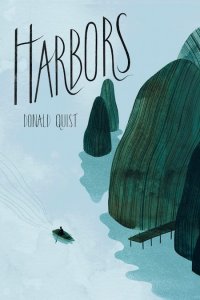 In terms of a holistic approach, I’m thinking about your first essay collection, Harbors. It contains a number of loosely hermit-crabby essays, often in the form of lists or instructions, like closing procedures, maps/directions, itineraries, and lesson plans, which elevates those forms into the realm of art—and asks, perhaps, that we consider the ways they might already function as art, a fluid dance of dailiness. Every new essay, quote, or micro-essay in your most recent collection, To Those Bounded, is numbered, giving the manuscript as a whole the progressive sense of a list. What do you think draws you to the list form specifically?
In terms of a holistic approach, I’m thinking about your first essay collection, Harbors. It contains a number of loosely hermit-crabby essays, often in the form of lists or instructions, like closing procedures, maps/directions, itineraries, and lesson plans, which elevates those forms into the realm of art—and asks, perhaps, that we consider the ways they might already function as art, a fluid dance of dailiness. Every new essay, quote, or micro-essay in your most recent collection, To Those Bounded, is numbered, giving the manuscript as a whole the progressive sense of a list. What do you think draws you to the list form specifically?
DQ: I love the clarity of enumeration; how well it can frame a work. Any reader can relate to making a list, and so there’s this natural familiarity and accessibility to list as a form. Lists also have this inherent tension to them. You could pick up a stranger’s grocery list and once you see a bulleted item, you’ll feel a compulsion to see what’s next.
I’m a list-maker. My home is filled with post-it notes. I find a lot of creative things I have written have emerged from lists I’ve made to organize my thoughts. And so, as those lists spiral into narratives, oftentimes keeping the idea/themes in that list form ends up serving the narrative, both as an organizing structure and a means of giving the piece forward momentum.
CCT: You weave external materials into To Those Bounded, too, placing—on their own pages—quotes from poetry collections, memoirs, stand-up comedy, theory, reports, philosophy, and film, mostly from Black creatives. This puts these materials into direct conversation with your writing, recontextualizing them and making them into something like a found poem or pastiche. I can also see you drawing on poetic tools in the micro-essays—those stark pages containing just a line or two including the phrase “every day,” as in, “Every day, fear being made into a hashtag. Every day—” and “Every day, avoid gathering outside with friends unless the majority of the group is white.”
In an interview, you described the micro-essays as an embodiment of the golden rule of design and personal mantra that form follows function, using the tension between presence and absence, printed word and surrounding space, to invite readers to make meaning with you. This is the same way poets engage space and line—those visual tools of the printed page. How else does poetry factor into your writing or process?
DQ: I read a lot of poetry. I look to poetry to see what’s possible. I’m enamored with how poetry can employ formal constraints to set tone and mood. I try to be mindful of line and whitespace in anything I write. I’m mindful of syntax and rhythm. All of that awareness comes from a deep appreciation of poetry. To Those Bounded is punctuated by pages that have a single couplet. When read together, those pages form a ghazal. So, I guess in that sense, poetry is the backbone of that project.
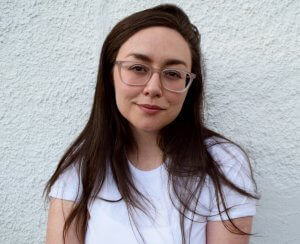 CCT: Oh, wow—I love that the ghazal sews the seams of To Those Bounded. What an ingenious use of the form’s movement and the couplet’s sense of bondedness.
CCT: Oh, wow—I love that the ghazal sews the seams of To Those Bounded. What an ingenious use of the form’s movement and the couplet’s sense of bondedness.
Speaking of movement, I once tried to use an episode of Seinfeld (“The Pez Dispenser”) to teach a lesson on poetic movement, pairing it with poems by Mary Ruefle. I’ve often said Ruefle’s poems and their associative movement remind me of a Seinfeld episode, where the story always winds up landing pretty far afield of the inciting incident. I admit that this lesson did devolve into simply enjoying an episode of Seinfeld in class—oh, well! Any tips on how Seinfeld might be, ah, better employed in the creative writing or literature classroom?
Or maybe you’d like to take this question as an opportunity to talk about narrative structure or movement—your own approaches, approaches in literature that have blown your mind or confounded you, or particular episodes of this show that have something to teach us about that.
DQ: First of all, this is why I admire you so much as an educator. The attempt to bring in materials students aren’t expecting to learn from is important. Making associations between seemingly disparate things is a beautiful act of making. Sounds to me like you employed that episode successfully.
I’m still thinking through and discovering all Seinfeld has, and will, teach me about creative writing, particularly poetic movement, and/or MacGuffins as a narrative technique. I love how often that device was used in 80s and 90s sitcom-storytelling. You have this inciting incident that falls away and by the end, in under thirty minutes, we’ve arrived at someplace wildly unexpected and yet totally probable through cause and effect. It’s an education in plot development. “The  Pez Dispenser” is a great example, and off the top of my head so is “The Subway.” It starts with a subway ride, and then moves into a confrontation about gay marriage, a blind violinist revealing himself to be an undercover cop, a bedroom robbery, and a trip to Coney Island with a nudist. It ends with dinner at Monk’s diner. Four plot lines running parallel to each other and converging to a surprising but inevitable ending. Flannery O’ Connor is rumored to have coined that, and though she was racist, I still like this possible quote and some of her stories…Sigh. [ed. note: let’s all take a moment and join Donald in this sigh]
Pez Dispenser” is a great example, and off the top of my head so is “The Subway.” It starts with a subway ride, and then moves into a confrontation about gay marriage, a blind violinist revealing himself to be an undercover cop, a bedroom robbery, and a trip to Coney Island with a nudist. It ends with dinner at Monk’s diner. Four plot lines running parallel to each other and converging to a surprising but inevitable ending. Flannery O’ Connor is rumored to have coined that, and though she was racist, I still like this possible quote and some of her stories…Sigh. [ed. note: let’s all take a moment and join Donald in this sigh]
I struggle with aspects of Seinfeld, too. There are quite a bit of problematic elements: “The Cigar Store Indian,” “The Puerto Rican Day,” like, all of Jerry’s standup bits about gender, yikes. How do you wrestle with and/or approach engaging with and/or teaching problematic texts?
CCT: You raise a good point about Seinfeld’s being a sometimes-troubled love—those episodes, among others, are difficult to sit with as a fan. The way I wrestle with a problematic text depends on context and the nature of its problems. There is, to take your Flannery O’Connor example, a difference between how I engage with her work on my own (turn outward; seek critical discourse or scholarship, particularly from writers and scholars belonging to communities misrepresented or negatively impacted by the text or author) and how I’d engage with her work in a class. And at that, there’s a difference between how we’d talk about Flannery O’Connor in a class on the Southern Gothic versus in a creative writing class, and even then, I’d consider, what level is this class, where are we in the world, and who are my students? No matter what, I’d need to have a good long think on why I’m assigning it, and then it would be important to acknowledge its issues in conversation.
That can actually release a pressure valve, I’ve found, particularly for students who are new to literary studies and arrive thinking that if a text is published and assigned, it’s unimpeachable. So it’s helpful to demonstrate early on that no text is immune to the kinds of prejudices, injustices, or cultural forces present in the waters of its birth, and that we’re allowed and encouraged to take on the texts’ faults in addition to its other qualities—to model that aspect of deep engagement with literature. That’s also one way a text lives—not only in recording the concerns of its maker and its time, but also in continuing to provoke the shifting concerns of its readership in their times, in continuing to function as vehicles for discourse and reflection.
DQ: YES! I agree with your approach. Taking time for the careful consideration and interrogation of every text is the best way to engage with, and teach, literature (and/or everything). I think it’s good practice for examining media written and performed from previous decades.
CCT: I’ve never seen Sex and the City, but I was thinking about that game / thought experiment where people try to determine whether someone is a Carrie, a Samantha, a Miranda, or a Charlotte, as if the four characters were cardinal directions by which everyone’s personality must at some point travel. What are the qualities of the Jerry, George, Elaine, Kramer matrix, and where could you see yourself fitting in? (Personally, I have always felt like a George sun, Elaine moon, Jerry rising.)
DQ: My gawd! Why has no one ever set up this matrix? I think you’ve got something here! Copyright this!
Since one of Larry David’s tenets for the show was, “No hugging. No learning,” I feel like Jerry, Elaine, George, and Kramer represent varying degrees of neutrality. Jerry is more of a true neutral, while Elaine has this very strong commitment to her own sense of right and wrong, a set of laws and principles she has created that others are expected to abide by. George is similar, in a way, but doesn’t often have the courage to stand for those internal ideals openly. Kramer is kind of a standard chaotic neutral, led primarily by his id and rushes of dopamine. They aren’t good or bad, which is why I dislike the ending of the series.
I identify as an Elaine sun and a Kramer moon with a George rising.
CCT: Based on my limited understanding of Freud, I can totally see Kramer as the id. Jerry, George, and Elaine all seem like variations of the ego—or would you argue for Elaine as a superego? And speaking of the incomparable Elaine Benes, could there be any connection between your undying love for her and Julia Louis-Dreyfus’s undying love for Baltimore, since you’re also from Maryland? I know you’re not a Sports Guy, but would you have taken off the Orioles hat?
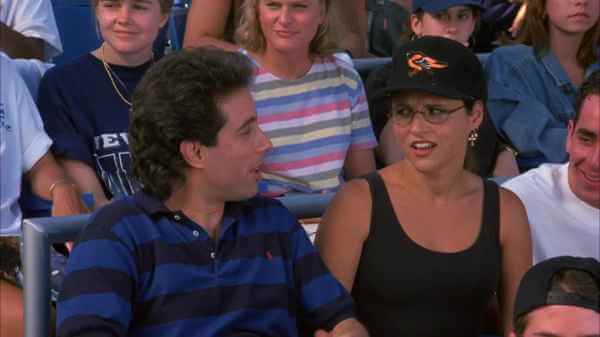 DQ: I have never thought about that. The character is from my home state. And, although I don’t like baseball, I love the Orioles logo and Cal Ripken Jr. If I’m being honest with myself, Caylin, I’d have removed my Orioles cap…George rising here.
DQ: I have never thought about that. The character is from my home state. And, although I don’t like baseball, I love the Orioles logo and Cal Ripken Jr. If I’m being honest with myself, Caylin, I’d have removed my Orioles cap…George rising here.
CCT: Fair enough—I probably would, too, although my Elaine moon would steam about it on the inside while my Jerry rising tries to turn it into a blasé joke.
You said in a flash interview with Assay that your favorite thing you’ve written is whatever project you’ve just started. What have you got cooking right now that makes you feel excited to write?
DQ: I just finished a first draft of a new novel. It’s got a lot of gaps, but I’m excited to do the work of filling them. It’s the same feeling of putting a puzzle together. There’s the sense of satisfaction when I figure something out; when I find the right piece that will pull a part of the vision together, most often in a way I could have never predicted.
I’m also working on new creative nonfiction. It’s been quite a while. I haven’t written personal essays since 2021. So far, it’s been really thrilling to get back to this type of making. Of course, there’s some anxiety to it, seeking out and capturing this level of vulnerability again, relearning how to be honest in a way that might resonate with readers. But I’m grateful for the inspiration and the process, and I am stoked to see how it might enliven me and others.
A surprising dearth of Seinfeld content appears in the X-R-A-Y archives. Submit us something here.

